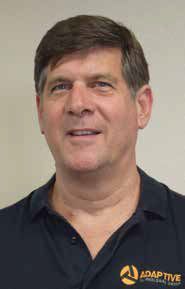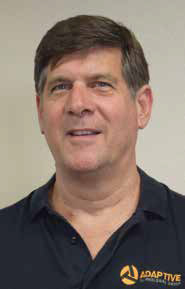
Quick Bio
Name: Paul Allen
Title: CEO
Company: Adaptive Technologies
Overtime: As a musician, Allen saw what types of equipment he needed to perform easier, and used his engineering skills to create his own solutions.
SCN: How did your personal interests lead you to starting Adaptive Technologies? What was it about audio and digital signage that drew you to this industry?
Paul Allen: I am a musician and musicians require lots of audio gear. I needed an accessory that did not exist, so I engineered an audio product and had it built by local vendors.
Before this, I worked with many companies helping the engineering departments design mechanical systems into the product lines of IBM, Xerox, Ford, General Motors, and just about all of the aerospace firms. So when I needed a product of my own, I was ready and shortly thereafter established Allen Products Company. Just eight miles away, another musician, Andrew Martin, created ATM Fly-Ware, which also designed and manufactured audio products. His audio products and ours blended perfectly, so in 2005, we bought ATM Fly-Ware and the combined companies then became known as Adaptive Technologies Group.
Digital signage was just starting to come of age. Our experience creating audio mounting and rigging solutions couldn’t have been more timely for creating solutions for the video wall and display market. Our first digital signage project was to provide two video walls (windows) for each of hundreds of Hollister stores that display a live surfer feed from the Huntington Beach pier, with one camera facing north and one south. It was a great project for us, and it quickly propelled us into the digital signage arena.
Personally, I possess a blend of multi-disciplined engineering and technical expertise, which I apply to commercial audio and video applications. The music industry though, has always been the driving force and a passion that I share with thousands of like-minded people in our industry.
SCN: What would you say makes Adaptive Technologies stand out in the industry?
PA: We’re kind of a go-to firm. What makes us stand out is that we creatively solve for AV installations but we also solve our customer’s liability. We understand materials, load limits, long-term environmental factors, install equipment, and we perform our own in-house destructive testing. We know structural engineering very well. From the customer’s point of view, we pretty much do the soup and nuts of an entire installation, taking the burden for our customers.
SCN: How has the industry evolved since you joined the industry? How have the needs of integrators changed?
PA: When we first started, speaker manufacturers did not provide mounting or rigging points in their speaker cabinets, save for the pole cup to put on top of tripod stand. They didn’t want the liability of mounting speakers to walls, ceilings, from poles, etc. Instead, they made the contractor prepare the cabinets for these installations.
Further, speakers are getting heavier and more intelligent with built-in amplifiers and computer interfaces that allow for remote adjustments of volume and EQ. They can even send messages back to the network saying ‘hey there’s something wrong with me, come fix me.’
The video industry has also rocketed ahead—flat screen monitors used to be pretty big and bulky, but now we’ve seen them lighten up, brighten up, use less power, and last longer. The basics are still the same, but the features, benefits, bells and whistles are getting better, plus the prices are coming down.
SCN: When rigging up an AV system, what should manufacturers keep in mind? What elements/ weather/etc. do you have to factor in now?
PA: Planning, planning, planning. What long-term effects will affect the installed gear? What weather and environmental factors need to be considered, such as corrosion, vibration, earthquakes, wind loads, snow loads, ice, etc—many installations stay exposed to the elements all year round. To sum up: What can go wrong, will go wrong, so be prepared at each step on the install.
For mounting and rigging installations, select experienced installers/ riggers. Have them develop a detailed installation plan for each step of the install. Create a safety plan based on each of these steps, including the move-in and the move-out. Review the structure of the venue where the installation will take place—has it been approved to support the weight with an adequate margin of safety? Will a hardware consultant be needed to help select the best hardware for the specific installation? Identify a secure staging area where the equipment can be stored prior to installation. Carefully check all entry and passageways at the venue and availability schedules to be sure that your gear and lift equipment can get to the install site, and check exit schedules to be sure that equipment can get out before walls, floors, and doors are completed.
SCN: What are your predictions for the future of the industry?
PA: Everything in audio and video is getting connected and networked, making the future for AV very bright. So many new developments and technologies are hitting us almost weekly. If that isn’t enough for us to keep up with, the old infrastructure is also being or will soon be replaced. Adaptive is investing in the future by producing solutions for all the new technologies and with the kind of designs that are easy to install, easy to use, and will last.
Kelleigh Welch is managing editor of SCN. Follow her on Twitter at @kelleighwelch










